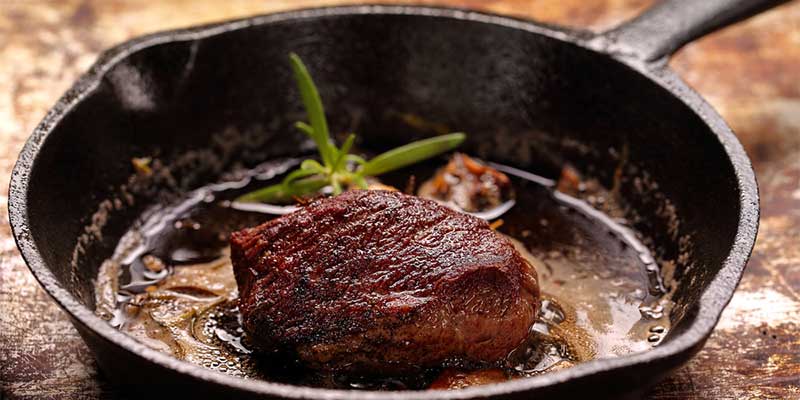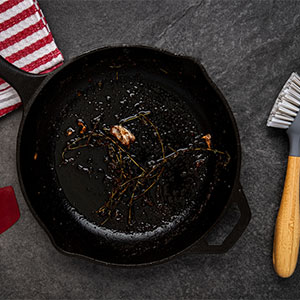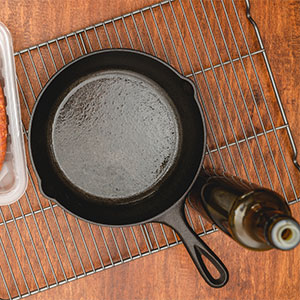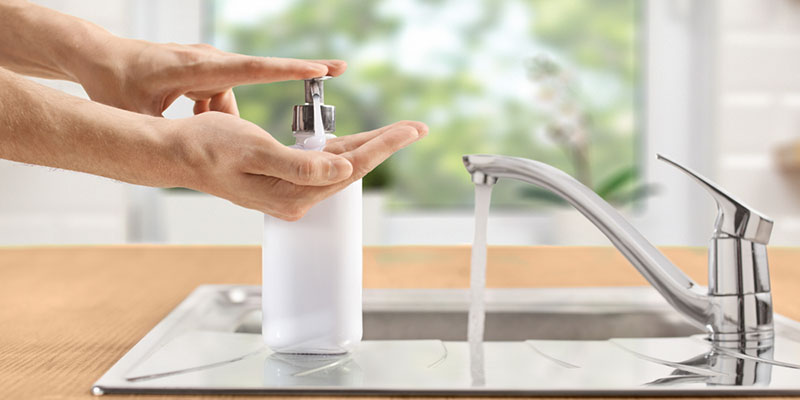How To Clean A Cast Iron Skillet With Burnt On

Cast-iron skillets are widely used because they’re easy to clean and maintain, have a long lifespan, and are durable as well. But if you don’t know how to clean a cast-iron skillet with burnt-on, well, that’s a problem.
However, it’s not a hard nut to crack. There are some easy ways to clean a burnt-on cast iron skillet that require less time and effort. In this article, you will get to know about the ways in detail.
And, guess what? You’re going to know some additional tips and tricks to upkeep your skillet as well. So, without having many chitchats, let’s get to the point.
2 Methods of Cleaning a Cast Iron Skillet with Burnt On
We have broken things into bite-sized chunks. Here you go with two easy methods of cleaning a burnt on cast iron skillet.
Method 1: Going through a Quick Cleaning
Here’s a method of quickly cleaning your cast iron skillet. If you need to clean it right now, by hook or by crook, there are ways. Let’s go and check!
 Step 1: Clean the Stuck Foods
Step 1: Clean the Stuck Foods
You are going to clean the stuck foods in the first place but there are different ways to do the job for different cases.
We have compiled 3 different situations here and broken down them into 3 different ways.
Way 1: Remove Lightly Stuck Food
If you are lucky enough to catch your food exactly when it begins to burn to the skillet, it will be easy to clean. Take 1-2 tablespoons oil (15-30mL). Is your skillet still warm? If it is, then pour the oil into it and then wipe down the surface using a paper towel.
Light foods should be disposed of easily with this oil-cleaning process. Once you are done, you can store and prepare the skillet for the next time you will cook with it. A point worth keeping in mind is, use an oil that has a high smoke point as well as a neutral taste, it will offer you the best results. It is best to use vegetable oil, flaxseed oil, or grapeseed oil.
This way is only for foods that are recently burnt onto your skillet. For more serious burns, you need to go through different paths.
Way 2: Scrub the Burnt Food Away
This way is about foods that are stuck for a little longer. In this case, you need to use something more abrasive, more than just oil. Use baking soda, kosher salt, or coarse sea salt instead. Gently scrub away any food stuck to your skillet using a paper towel. Then, rinse the skillet lightly to get rid of any leftover baking soda or salt.
You can pick any abrasive powder to do this job. However, using cornmeal works great instead of baking soda. But if you use sugar or something like that, it may melt onto your skillet’s surface and then you need to clean something else.
Way 3: Get Rid of More Difficult Foods
Now, we will talk about foods that had a long time to burn and stuck onto your skillet. What you can do is to fill the skillet with 1 inch of water. Then, place your skillet over medium heat. Once the water starts simmering and boiling, try to remove the burnt-on food using a plastic or wooden spatula.
When you are done with cleaning it, pour every drop of water out as well as leave your skillet fully dry before you use it again or store it. Another point to be noted, try to use only wooden or plastic appliances in your cast iron pans instead of anything metal. Otherwise, metal spoons or spatulas can scratch the surface or remove the seasoning on your pans.
Step 2: Dry Your Skillet
Now, you have to wipe down the surface of your skillet using a dry cloth to remove the excess water. Next, set the temperature of your oven to 350℉. Put the skillet in the oven and wait for 10 minutes. You can do the same thing over a medium-high stovetop. It also will help your skillet to completely dry.
Remember, if any water is left on the skillet during storing it, you may notice rust after some days. So, it’s crucial to make sure that your skillet is utterly dry before you oil it or store it.
Step 3: Apply a Dash of Oil on the Clean Skillet
 It’s always good to apply a thin coat of oil over a cast iron skillet after every time of using it. When the skillet is still warm, take 1-2 tablespoons of oil and pour it into the skillet. Now, spread the oil all over the surface of your skillet with a paper towel. Finally, you can put your skillet away in a dry place until the next use.
It’s always good to apply a thin coat of oil over a cast iron skillet after every time of using it. When the skillet is still warm, take 1-2 tablespoons of oil and pour it into the skillet. Now, spread the oil all over the surface of your skillet with a paper towel. Finally, you can put your skillet away in a dry place until the next use.
What happens here is, the oil over the warm surface of your skillet reacts with the cast iron and builds up a polymer. And, it will keep your skillet non-stick as well as in a good condition for a long period. However, if you already have used oil during cleaning the skillet, it’s okay to skip this part.
Pick an oil having a high smoke point during seasoning your pan. What we said before is, vegetable oil, grapeseed oil, and flaxseed oil will work great.
Method 2: Restoring and Seasoning
In case, you are not able to have a quick cleaning, well, there are ways too. You can go through the restoring and seasoning process. Let’s get into the details.
Step 1: Scrub the Skillet
First of all, take a little dish soap and pour warm water into your skillet. Next, start scrubbing it using a small ball of steel wool. Continuously scrub until you meet the natural, unfinished cast iron (that may be in blue-gray color).
You may hear from some sources that you never should use soap or steel wool on a cast-iron skillet. Well, this is good advice for a day-to-day clean. However, this is an essential step while stripping or seasoning a skillet.
Step 2: Clean Your Skillet
Now, it’s time to take a damp cloth and clean gently the inside of the skillet. Continue cleaning until you see the water runs totally clear. Lightly wash the surface of your cast iron to get rid of any rust or particles.
Step 3: Let the Skillet Dry
In this step, you need to dry the skillet by putting it in a hot oven. To do so, preheat the oven to 350℉. Before you put it in the oven, wipe away the leftover moisture on the surface of the skillet with a clean and dry cloth.
Wait for 10 minutes, then, take your skillet out of the oven. Get a thick tea towel and place the skillet on it, it will keep the skillet from the direct touch of your work surface.
And, if you want to dry the skillet on the stove, then yes, you can do it as well. Put it over medium-high heat and wait until all the water evaporates and your skillet dries completely.
Step 4: Apply Oil Over the Skillet
For seasoning your cast iron skillet, take 1-2 tablespoons of oil that has a high smoke point. You can use vegetable oil, flax oil, or grapeseed oil in this case, all of them will work great.
Use a paper towel to spread the oil over the surface of your skillet and also, remember to wipe any excess oil away.
A point worth noting is, cast iron has a lot of small holes all over its surface. This is why it’s called porous. The holes absorb oil and consequently, it gives the skillet a smoother cooking surface.
However, do not leave too much oil on your skillet. Otherwise, it can become sticky since you cook with it.
 Step 5: Put Your Skillet in the Oven
Step 5: Put Your Skillet in the Oven
Turn on your oven and set the temperature to the highest heat (around 500℉). Then, put a tin foil on the lowest rack, it will catch excess oil that may come off the skillet.
Now, place your skillet upside down on the peak of the rack.
Leave the skillet in the oven and let it cook for at least 1 hour. This is how you will be done with seasoning. Wait, there’s one more step!
Step 6: Cool your Skillet and Repeat the Seasoning
Turn off your oven after a straight one hour and let your skillet cool down. Once it’s cool, you’ll find the skillet clean, seasoned, and perfectly okay to use.
But you should oil and bake the skillet once more to get the best results.
This will allow the skillet to form the coating of oil and make it last longer. Then, put your skillet away in a dry and clean place. Since cast iron rusts quickly, you need to keep it away from moisture, as much as you can.
Tips to Clean Skillet even More Efficiently
When it’s about your kitchen appliance, efficient cleaning is crucial. Your kitchen utensils do not require hard work, putting less effort is okay but you need to clean them regularly.
Try to apply some eco-friendly tricks and tips that also will help you to save some effort.
The very first thing we want to say, do not underestimate the power of water! If you simply soak your pans or pots in the water before you are going to clean them, it will eliminate the grease more easily. And, it saves some of your time as well.
In case you see any rusty patch in your skillet, use an abrasive (e.g kosher salt) right before you wipe it out using an oily towel.
We recommended kosher salt for removing stuck-on food. If you are looking for something easier and eco-friendly, you can use vinegar and baking soda instead. Moreover, you can remove the remaining burnt-on food using lemon juice and salt.
We stored the best one for the last, here’s a pro tip, if you sprinkle a dash of baking soda on the skillet, you will get a dry cast-iron surface in no time!
Additional Tips for Maintaining a Cast-Iron Skillet
All the methods we have mentioned will surely work to clean your cast-iron skillet. But regular cleaning is the surefire way to keep your skillet lustrous and durable.
Here are some additional tips that will help you maintain and take care of your skillet.
- Be very careful with your skillet while storing it. What it means is, you must realize the importance of heavy seasoning. Try to furnish your skillet with a protective coating of oil. This will help your skillet prevent rust.
- If you haven’t used the skillet for a long time like one week or more, use heavy oils that contain saturated fat (e.g coconut oil). However, it is okay to use vegetable oils for short-term care.
- And, here’s the most controversial point, is it okay to use soap? Well, you should use soap while seasoning the cast-iron skillet. But be very careful about using any abrasive, do the scrubbing job very gently.
- Store the skillet in a dry and cool place to avoid exposure to prolonged moisture. Otherwise, there’s a risk of having rust on your skillet.
Conclusion
And, that’s that! We’re done talking about how to clean a cast-iron skillet with burnt on. Is this still greek on you? Hopefully, your answer is a big NO as we put here about every relevant information about this topic.
Cleaning is not a big deal but seasoning, storing, and maintaining a cast-iron skillet regularly is a bit of a hard task to do. However, if you want your skillet to last longer, you need to be careful about the above-mentioned terms.
And, try your best to follow every method, every step carefully to make your burnt-on skillet looking new. If you can do the job properly, you’ll be surprised to see the sparkling skillet!




